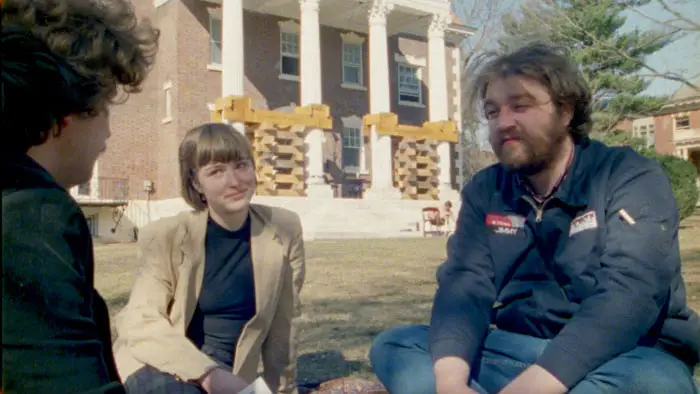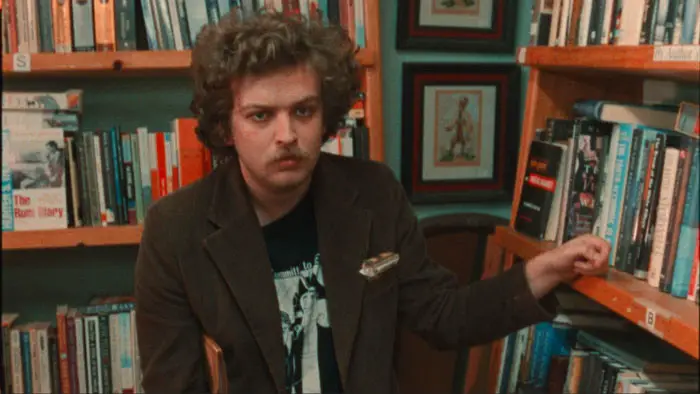
In a quiet classroom in Burlington, Vermont, students nod along to the words of a professor. The diminutive figure scolds his class. To the right of the lecturer, a young man lies, impaled by a katana and holding a thick paperback. The speaker continues, “Sometimes, when you see an undergraduate lying on the floor, holding a copy of Bunion’s Pilgrim’s Progress and playing dead, don’t be afraid to say, ‘That’s an undergraduate lying on the floor, holding a copy of Bunion’s Pilgrim’s Progress and playing dead!’” Class dismissed.
Pomp and Circumstance, directorial debut for filmmakers Adrian Anderson and Patrick Gray, is nothing you haven’t seen before– and more. In stylish vignettes, Anderson and Gray explore the existential tribulation of three undergraduate students: Charlie, Marie, and Thomas. The trio is pulled from collective ennui by the dark designs of Professor James Cherry, having announced his mayoral campaign and his intent to purge Burlington of ‘low’ art. As ‘JC’ stokes flames of righteous indignation in Burlington’s student body, Charlie, Marie, and Thomas must push back, saving their beloved karaoke bar from certain doom.
Characters in Pomp and Circumstance have an effusive, self-indulgent way of speaking. Shortly after our heroes are introduced, strolling along a picturesque avenue, they discuss Charlie’s decision to be homeless (while having wealthy parents). Thomas, cigarette in hand, announces that “Ennui is French for solipsism, and solipsism is French for Interesting.” Quickly, our attention is called to another display of post-modern posturing from Marie; “French is an incomprehensible language, which is sexy.” And on and on. The trio wanders off, and a pedestrian prattles on about “Chomsky’s fidelity to the Enlightenment” and “biologically predetermined grammar.” This continues throughout the film: Each and every Burlington resident has a passionately performative perspective to share.

“As ‘JC’ stokes flames of righteous indignation in Burlington’s student body, Charlie, Marie, and Thomas must push back.”
The narrative unfolds in distinct sequences, complete with intertitle–from comedic interludes to character studies to an overwrought investigation of Elvis’s pelvic physics. This opens the doors for interplay between these sequences, including a constant flow of metatextual gags, each of which calls attention to the film’s existence as a film. In one sequence, “Charlie’s First Date of the Month,” Charlie’s date at a music shop is destroyed by a sudden rash of editing ‘mistakes.’ Abrupt cuts disrupt the flow of conversation and ruin his evening.
Ultimately, Pomp and Circumstance produces a sense of cohesive charm and palpable nostalgia. Patrick J. Malone is excellent as Professor Cherry, delivering a performance that is pompously comedic and a little frightening. For all their flaws, for all their bemoaning the scenery, our main characters feel familiar. The style is confrontational, but the jokes land. Anyone who has endured ‘art school’ is invited to reminisce, cringe, and laugh along.
This feels like a student film. That is to say, an ‘artistic film,’ or a debut film, or a passion project, or any number of terms to describe a movie that should be critiqued carefully, respecting its limitations. Viewed as a whole, Pomp and Circumstance is greater than the sum of its parts. The sheer volume and interplay of filmmaking tropes reveal filmmakers who fundamentally understand their craft. The joke is on critics: Co-writer/directors Andrian Anderson and Patrick Gray have purposefully adopted the posture of student filmmakers, exemplifying– and reveling in–the ‘limitations’ of the style. Like Prof. Cherry, Anderson and Gray are hoping that someone will point out the obvious. In fact, I think they are proud of it.

"…purposefully adopted the posture of student filmmakers, reveling in the ‘limitations’ of the style."


